Angelos Akotantos
Angelos | |
|---|---|
Icon of the Mother of God and Infant Christ (Virgin Eleousa) | |
| Born | |
| Died | 1450 |
| Nationality | Greek |
| Known for | Iconography and hagiography |
Notable work | The Virgin Cardiotissa, The Congregation of the Archangels, Sts Peter and Paul, Deisis, St. Phanourios killing the Dragon |
| Movement | Cretan School |
| Spouse(s) | Eleni Marmara |
Angelos Akotantos (Greek: Άγγελος Ακοτάντος) was a painter, educator, and protopsaltis. He painted in the Byzantine style or maniera greca. He represented the transition from the Byzantine style of painting to the more refined Cretan School. Angelos students were Andreas Pavias, Andreas Ritzos, Antonios Papadopoulos, and Nikolaos Tzafouris. He influenced the future artists of the Cretan School namely Georgios Klontzas, Theophanes the Cretan, Michael Damaskinos and El Greco. Angelos brother Ioannis Akotantos was also a famous painter. There are 50 paintings all over the world by Akotantos. Thirty are signed and twenty have been reliably attributed to the artist.[1][2][3][4]
History[]
Angelos Akotantos was born in Crete. He had a sister and two brothers; one of the latter was the famous painter Ioannis Akotantos. Much information about Angelos’ life is drawn from the will he composed in 1436, in advance of a planned journey to Constantinople. The document is now housed in the State Archives of Venice.[5] At the time of writing, Angelos was married to Eleni Marmara and they were expecting their first child. He was relatively wealthy with a significant number of possessions.[6]
Angelos enjoyed a high level of education— as demonstrated by his ability to write his own will— and owned a big and valuable library. He specified that if his child died young the books in this library should be sold and the money raised should go to charities of his choice. Alongside his painting activities, he was a chanter and teacher of music; the Venetian authorities appointed him protopsaltis (first chanter), an honorable position carrying a government salary.[7]
He was familiar with the monastic superior of Saint Phanourios at Versamonero, and the will grants the institution a sum of money to hold memorial services after his death. He also had a relationship with the monastery of Saint Catherine, leaving them an icon of the eponymous saint.[8]
Akotantos’ paintings are extremely popular and his style has been copied by many icon painters. Copies of his paintings can be found in churches and private collections all over the world namely Greece. One church that exhibits a copy of an Akotantos painting is the Church of St. Symeon, Mytilene. They have Saint Anne with the Virgin.[9]
Akotantos was one of the most important Greek painters of the first half of the 15th century. The center of Byzantine art was transferred from the capital of the Constantinople to Heraklion because of the fall of Constantinople in 1453. He supplied icons to Greek churches and monasteries on Crete, Patmos, Rhodes, and elsewhere. Akotantos painted icons of Saint Phanourios killing the dragon, similar to Saint George, a local tradition found in the icons of the 15th century in Crete. Many scholars believe that the famous painter Angelos who is responsible for countless paintings is actually Akotantos. He inspired countless painters and most of his work is emulated even until today.[10][11]
Gallery[]

The Virgin and Child

The Virgin Cardiotissa
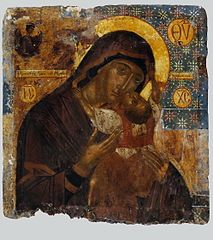
The Virgin and Child

Saint Anne with the Virgin

Saint Fanourious

St George on Horseback, Slaying the Dragon

St George
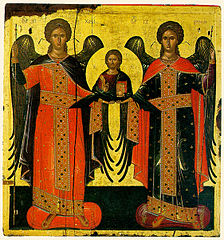
Congregation of the Archangels

John the Baptist
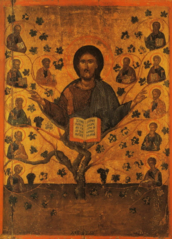
Tree of Jesus

Christ Pantocrator on a Vine

Tree of Jesus with Scenes
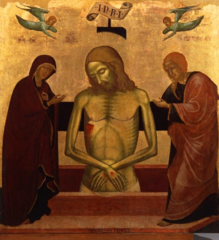
Jesus, Mary, and Saint John

Jesus by Angelos
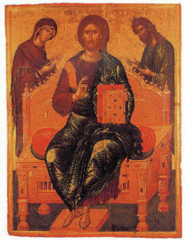
Christ Enthroned

Christ Enthroned
See also[]
- Hagiography
- Iconography
- Michael Damaskenos
- Nikolaos Lampoudis
References[]
- ^ Richardson, Carol M. (2007). Locating Renaissance Art. United Kingdom: Yale University Press. p. 200.
- ^ Achimasto Patamianoy, Mirtali (1991). Two Paintings of Andreas Ritzos and Angelos Akotantos at the Byzantine Museum (PDF). Athens GR: Journal of the Christian Archaeological Society. p. 118.
- ^ Icon of the Mother of God and Infant Christ (Virgin Eleousa), c. 1425-1450 attributed to Angelos Akotantos (Greek, c. 1450) at the Cleveland Museum of Art
- ^ Byzantium's Artistic Legacy Mark Rose. Archaeological Institute of America. 7 November 2002. Retrieved 7 April 2016.
- ^ C.M. Richardson, K. Woods, M.W. Franklin, "Renaissance art reconsidered: an anthology of primary sources" Google Books
- ^ Richardson, 2007, p. 178
- ^ Richardson, 2007, p. 178
- ^ Richardson, 2007, p. 178
- ^ Richardson, 2007, p. 178
- ^ Icon of the Mother of God and Infant Christ (Virgin Eleousa), c. 1425-1450 attributed to Angelos Akotantos (Greek, c. 1450) at the Cleveland Museum of Art
- ^ M. Vassilaki, "The Painter Angelos and Icon-Painting in Venetian Crete", Farnham 2009
External links[]
 Media related to Angelos Akotantos at Wikimedia Commons
Media related to Angelos Akotantos at Wikimedia Commons- List of works of art shown in the exhibition "Byzantium: Faith and Power (1261–1557)", The Metropolitan Museum of Art, New York, March 23-July 4, 2004.
- Article in the newspaper Kathimerini
- Byzantium: faith and power (1261-1557), an exhibition catalog from The Metropolitan Museum of Art (fully available online as PDF), which contains material on Akotantos
- 15th-century Greek people
- 1450 deaths
- Artists from Heraklion
- Cretan Renaissance painters
- Christian hagiographers
- Icon painters
- 15th-century Greek painters
- 15th-century Greek educators
- 15th-century Greek musicians













